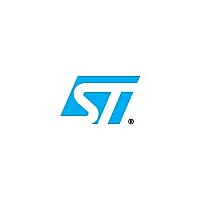ST72334N4 STMicroelectronics, ST72334N4 Datasheet - Page 33

ST72334N4
Manufacturer Part Number
ST72334N4
Description
8-BIT MCU WITH SINGLE VOLTAGE FLASH MEMORY,ADC, 16-BIT TIMERS, SPI, SCI INTERFACES
Manufacturer
STMicroelectronics
Datasheet
1.ST72124J2.pdf
(153 pages)
Specifications of ST72334N4
Clock Sources
crystal/ceramic resonator oscillators or RC oscillators, external clock, backup Clock Security System
4 Power Saving Modes
Halt, Active-Halt, Wait and Slow
Two 16-bit Timers With
2 input captures (only one on timer A), 2 output compares (only one on timer A), External clock input on timer A, PWM and Pulse generator modes
- Current page: 33 of 153
- Download datasheet (3Mb)
10 INTERRUPTS
The ST7 core may be interrupted by one of two dif-
ferent methods: maskable hardware interrupts as
listed in the Interrupt Mapping Table and a non-
maskable software interrupt (TRAP). The Interrupt
processing flowchart is shown in
The maskable interrupts must be enabled by
clearing the I bit in order to be serviced. However,
disabled interrupts may be latched and processed
when they are enabled (see external interrupts
subsection).
Note: After reset, all interrupts are disabled.
When an interrupt has to be serviced:
– Normal processing is suspended at the end of
– The PC, X, A and CC registers are saved onto
– The I bit of the CC register is set to prevent addi-
– The PC is then loaded with the interrupt vector of
The interrupt service routine should finish with the
IRET instruction which causes the contents of the
saved registers to be recovered from the stack.
Note: As a consequence of the IRET instruction,
the I bit will be cleared and the main program will
resume.
Priority Management
By default, a servicing interrupt cannot be inter-
rupted because the I bit is set by hardware enter-
ing in interrupt routine.
In the case when several interrupts are simultane-
ously pending, an hardware priority defines which
one will be serviced first (see the Interrupt Map-
ping Table).
Interrupts and Low Power Mode
All interrupts allow the processor to leave the
WAIT low power mode. Only external and specifi-
cally mentioned interrupts allow the processor to
leave the HALT low power mode (refer to the “Exit
from HALT“ column in the Interrupt Mapping Ta-
ble).
10.1
INTERRUPT
This interrupt is entered when the TRAP instruc-
tion is executed regardless of the state of the I bit.
the current instruction execution.
the stack.
tional interrupts.
the interrupt to service and the first instruction of
the interrupt service routine is fetched (refer to
the Interrupt Mapping Table for vector address-
es).
NON
MASKABLE
Figure
SOFTWARE
18.
It will be serviced according to the flowchart on
Figure
10.2 EXTERNAL INTERRUPTS
External interrupt vectors can be loaded into the
PC register if the corresponding external interrupt
occurred and if the I bit is cleared. These interrupts
allow the processor to leave the Halt low power
mode.
The external interrupt polarity is selected through
the miscellaneous register or interrupt register (if
available).
An external interrupt triggered on edge will be
latched and the interrupt request automatically
cleared upon entering the interrupt service routine.
If several input pins, connected to the same inter-
rupt vector, are configured as interrupts, their sig-
nals are logically NANDed before entering the
edge/level detection block.
Caution: The type of sensitivity defined in the Mis-
cellaneous or Interrupt register (if available) ap-
plies to the ei source. In case of a NANDed source
(as described on the I/O ports section), a low level
on an I/O pin configured as input with interrupt,
masks the interrupt request even in case of rising-
edge sensitivity.
10.3 PERIPHERAL INTERRUPTS
Different peripheral interrupt flags in the status
register are able to cause an interrupt when they
are active if both:
– The I bit of the CC register is cleared.
– The corresponding enable bit is set in the control
If any of these two conditions is false, the interrupt
is latched and thus remains pending.
Clearing an interrupt request is done by:
– Writing “0” to the corresponding bit in the status
– Access to the status register while the flag is set
Note: the clearing sequence resets the internal
latch. A pending interrupt (i.e. waiting for being en-
abled) will therefore be lost if the clear sequence is
executed.
register.
register or
followed by a read or write of an associated reg-
ister.
ST72334J/N, ST72314J/N, ST72124J
18.
33/153
Related parts for ST72334N4
Image
Part Number
Description
Manufacturer
Datasheet
Request
R

Part Number:
Description:
STMicroelectronics [RIPPLE-CARRY BINARY COUNTER/DIVIDERS]
Manufacturer:
STMicroelectronics
Datasheet:

Part Number:
Description:
STMicroelectronics [LIQUID-CRYSTAL DISPLAY DRIVERS]
Manufacturer:
STMicroelectronics
Datasheet:

Part Number:
Description:
BOARD EVAL FOR MEMS SENSORS
Manufacturer:
STMicroelectronics
Datasheet:

Part Number:
Description:
NPN TRANSISTOR POWER MODULE
Manufacturer:
STMicroelectronics
Datasheet:

Part Number:
Description:
TURBOSWITCH ULTRA-FAST HIGH VOLTAGE DIODE
Manufacturer:
STMicroelectronics
Datasheet:

Part Number:
Description:
Manufacturer:
STMicroelectronics
Datasheet:

Part Number:
Description:
DIODE / SCR MODULE
Manufacturer:
STMicroelectronics
Datasheet:

Part Number:
Description:
DIODE / SCR MODULE
Manufacturer:
STMicroelectronics
Datasheet:

Part Number:
Description:
Search -----> STE16N100
Manufacturer:
STMicroelectronics
Datasheet:

Part Number:
Description:
Search ---> STE53NA50
Manufacturer:
STMicroelectronics
Datasheet:

Part Number:
Description:
NPN Transistor Power Module
Manufacturer:
STMicroelectronics
Datasheet:

Part Number:
Description:
DIODE / SCR MODULE
Manufacturer:
STMicroelectronics
Datasheet:










